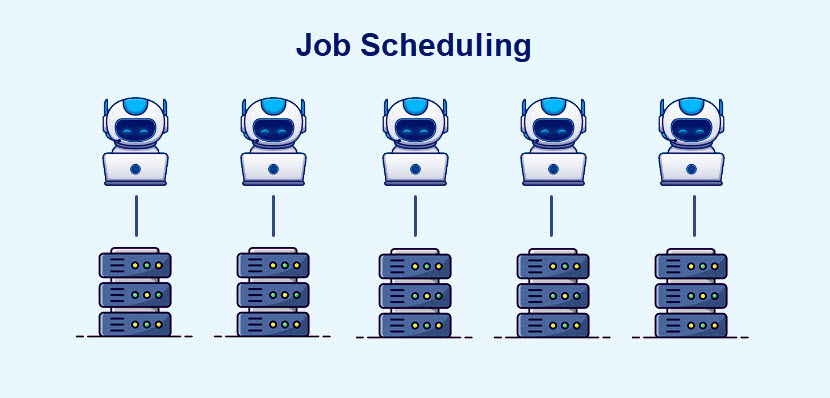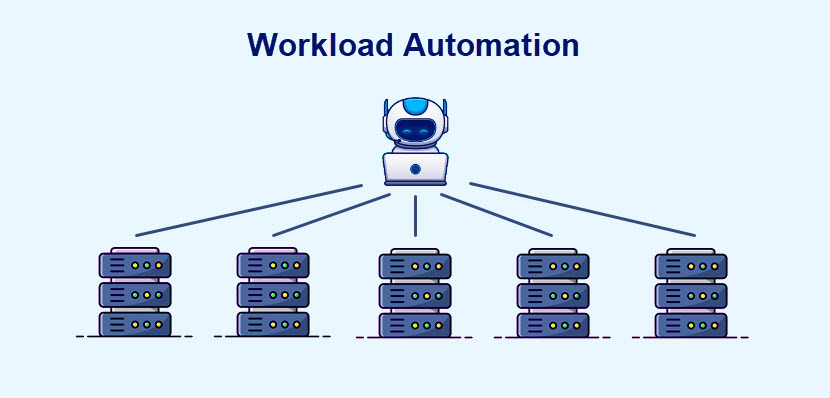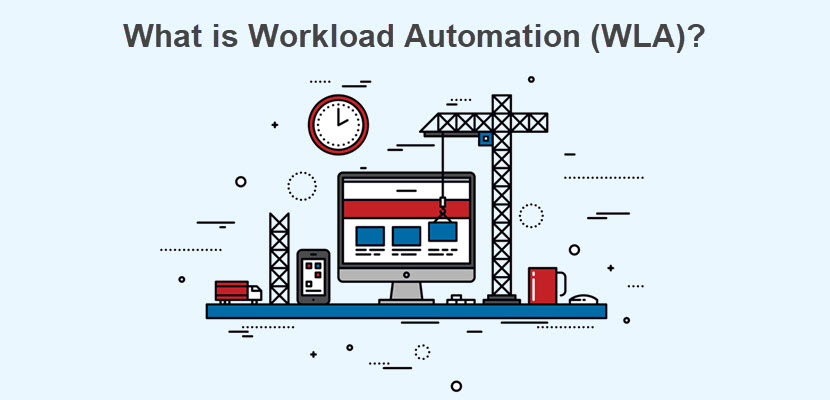Workload automation is a centralized solution for repetitive tasks that are prone to errors. It benefits both the IT team and the business. Workload automation is a centralized solution for error-prone repetitive tasks, which benefits the IT team and the business equally.
This article defines workload automation (WLA), provides a list of WLA tools, and lists its benefits.
What is Workload Automation?
Workload automation (WLA) is the process of employing software solutions to schedule and control tasks related to business transactions and operations. As a result, WLA eliminates the need for manual intervention.Compared to other automation processes, WLA focuses on real-time processing, resulting in automated event-driven and situational actions. Workload automation works with heterogenous and disparate systems to automate business procedures.
When automation includes data dependencies between systems and processes, skilled IT personnel can focus on new areas instead of repetitive error fixes in communication between systems and processes.
Since many different automation approaches exist, the following section briefly compares workload automation and other processes.
Job Scheduling vs. Workload Automation
Below is a brief comparison of job scheduling and WLA.
Job Scheduling
Job scheduling is a rudimentary type of workload automation that uses a single system to automate batch processing. Each major operating system includes a job scheduler. For example, Linux implements cron jobs, while Windows uses the Windows Task Scheduler.
Jobs activate on pre-defined time schedules (e.g., every Monday) or after an event (e.g., after a completed batch job). Job scheduling is platform-specific and limited to a single environment.
To summarize, job scheduling requires manual intervention, lacks OS coordination, and requires additional scripting and development resources to handle inconsistencies.
Workload Automation

WLA also automates batch jobs while addressing the problems of job scheduling. Workload automation allows you to centralize the configuration of workloads, rather than working on different servers. There are less errors and manual intervention. Workload Automation
The following section briefly compares RPA (robotic process automation) and WLA.
RPA (Robotic Process Automation)
Robotic process automation (RPA) is a technology for automating repetitive and rule-based tasks in low-variance systems. RPA software (bots) are lightweight and aim to complete labor-intensive processes that take a lot of time when done manually.

Under the hood, RPA is a collection of scripts without dynamic responses to changes. The bots train for specific GUIs and provide superficial automation.
As systems and businesses grow, user interfaces are bound to change. RPA tools require manually adapting to these changes, which means that a minor change can have a considerable impact and requires bot maintenance.
Workload Automation
Workload automation avoids common RPA pitfalls by integrating programmatically instead of on a user interface level. WLA is enterprise software that takes into account the fact that businesses grow and change. The solution easily replaces several RPA tools and avoids the need for custom scripts.
History and Evolution of Workload Automation
The origins of WLA come from batch processing. Batch jobs would run during low activity times, notably at nighttime, since they require extensive computing resources.
Over time, batch processing increased in complexity. Overnight windows were no longer sufficient for IT staff, who now had to handle more data and tasks. WLA was developed to address the problem of traditional scheduling methods not being able to keep up with workload. Workload automation tools were introduced as business environments expanded their tool sets. By evolving with the industry demands, WLA tools allowed cross-platform processes and continued to minimize manual intervention.
Workload Automation Benefits
Implementing workload automation comes with many advantages. Let’s examine a few beneficial features below:
Reliable. WLA systems are a vital part of many organizations. They rely on their accuracy and precision. The consistency of workload automation tools ensures tasks are completed on time and in compliance with business policies.
Consistent. Workload automation helps automate any part of an enterprise system, and working across different systems and servers creates a consistent automation environment.
Compatible. The latest solutions integrate seamlessly with all the latest systems and technologies, regardless of platform. Features like API connectivity make the WLA system simple to integrate across an enterprise.
Centralized
The system is easier to manage with a centralized control point. Pipeline creation and management across enterprises, operating systems, and third-party apps happen through a single interface.
- Economical. WLA tools scale up and follow business needs consistently with no additional costs.
- Reduced workload. The workload of skilled employees is reduced when manual intervention is minimized. This increases overall staff efficiency. Less human intervention means fewer errors, and complex tasks are simple to set up without additional scripting.
- Flexible. WLA systems can adapt in real-time to the needs of enterprises. The solution scales up and down quickly, without additional workforce training and education.
- Workload Automation Tool TypesBelow is a list of workload automation tool types and the problems they address.
- 1. Scheduling ToolsScheduling tools represent the most basic form of work automation tools. These solutions focus on job scheduling and reduce human interventions to a minimum.
- Pros: Often free to use and sufficient for basic scheduling and automation.
- Cons: Lacks advanced features, requires lots of scripting, and lacks cross-platform and cross-infrastructure integration.
These tools offer more features than a job scheduler. The solutions appear as part of a specific application or platform and focus solely on automating jobs within that system.
Pros: A specialized integrated solution for a given platform.
Cons: Lacks external integration and support and is not designed for cross-enterprise workloads.3. Universal Workload Automation Tools
Universal workload automation tools are proper workload automation solutions. The solution automates any software task and works throughout various infrastructures, operating systems, and applications.Universal workload automation tools include cloud infrastructure deployment and management through event-driven automation.
Pros: Provides a single centralized management tool for most platforms and solutions, making them easy to learn and maintain.
Cons: Costly and less capable than point tools for specialized use cases.
Best Workload Automation ToolsThe following section outlines examples of the best universal workload automation tools. Other tools exist, and we recommend you further research workload automation options to find the best fit for your environment.
1. The Redwood
tool automates hybrid cloud, on-premises and in-cloud system processes. The solution easily automates hybrid cloud, on-premises, and in-cloud system processes.
Redwood has the following features:
API wizards for incorporating SOAP and REST services quickly.Data pipeline management and planning through integration with big data solutions such as Hadoop or Snowflake.
Integrated connectors are readily available for orchestrating automation. Redwood offers a great solution for SaaS Workload Automation with a pay-per-use pricing model. IBM Workload Automation is designed to improve decision-making through centralized management, predictive analytics and business intelligence. Essential features include a robust integration between containers, workload automation, and monitoring from various devices.
Other features of IBM Workload Automation include:
A powerful and easy-to-use automation dashboard.
Hierarchical directory organization for jobs and job streams with identity and access management.
RedwoodContainer deployment for all workload automation components.
IBM Workload Automation works with batch and real-time workload management and is an ideal solution for small and large businesses.
- 3. ProActive
- provides a solution for job scheduling and orchestration, as well as workload automation. The user-friendly scheduling system features an error management system, priority organization, and event-based execution.
- Some additional features of ProActive are:
Extensive logging features for monitoring and analysis.
Advanced error management through intermediate results and policies on global and granular levels.
IBM Workload AutomationSupports public and private cloud, on-premises data centers, HPC, and hybrid cloud environments.
ProActive additionally integrates into existing CI/CD pipelines and provides control over scaling.
- 4. JAMS Scheduler
- provides enterprise-level tools for job scheduling and workload automation. The solution supports processes in various operating systems, enabling a direct implementation of intelligent automation.
- Features of JAMS include:
Batch process functionalities and automation.
Application managers for easier business application integration.
ProActive Support for various kinds of on-premises, in-cloud, and hybrid cloud environments.
JAMS is an excellent solution for processes with complex steps and settings for small and large businesses.
- 5. ActiveBatch , an intelligent WLA tool, adapts to changing conditions. The solution offers broad integration support for various third-party apps, databases, and platforms.
- Additional features of ActiveBatch include:
Access to the most extensive no-code library with prebuilt integrations at no additional cost.
API accessibility for loading and executing various API types and services.
JAMS Intelligent queue management through machine learning for reduced bottlenecks in distributed environments.
ActiveBatch is a customizable and adaptable solution created for medium to large-sized enterprises.
- Modern systems are complex networks of various tools and software. WLA is a centralized solution and a must-have in contemporary business environments.
- Businesses should expect workload automation to evolve further, with increased support for multi-cloud and hybrid cloud environments.
